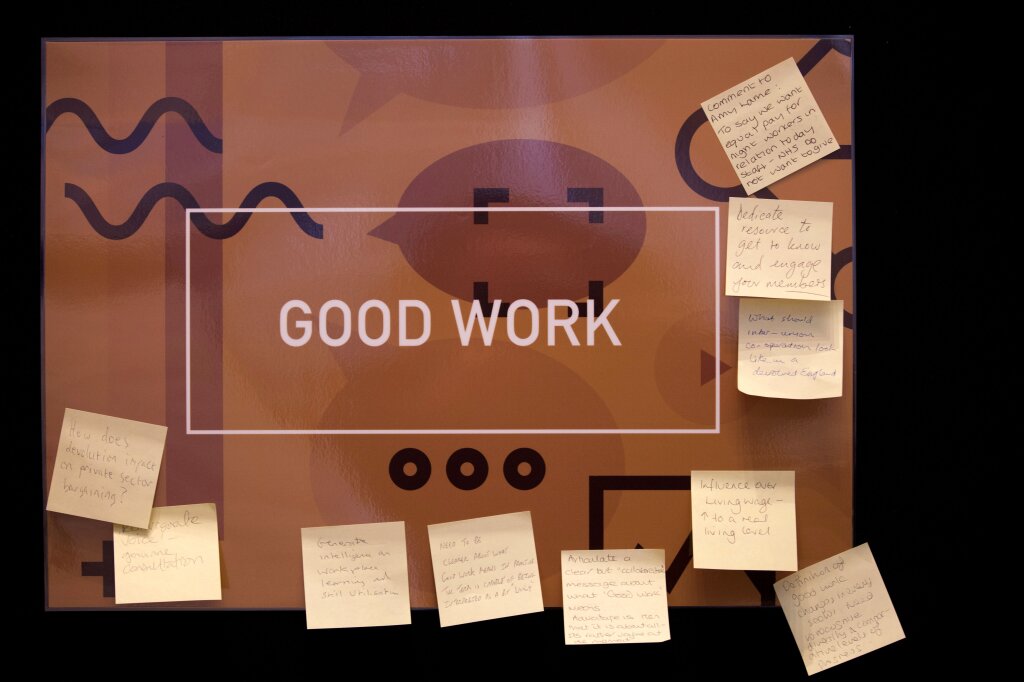By Becky Wright | 4 min
As we come up to beginning a new round of research and projects, I am beginning to think about the conversations with union supporters over the last year and how we can begin to address them. Our supporters are key in helping shape our work agenda and at our conference this year, we had a great round of ideas generated on our boards.
In our 'Good Work' stream, the ideas generated have got me thinking about what will collective bargaining look like going forward.
In the UK, there are broadly three ways that collective bargaining has taken place: through Multi-Employer Bargaining (MEB) where agreements are created covering all businesses with in a particular sector or industry, social partnership, which includes government or political institutions or plant-based deals. We are now in a period of fragmentation, from dominant MEBs to ad hoc plant-based deals. There isn't inherently wrong with that, but the move to plant-based deals generates problems for unions, especially with in new sectors.
The difference between the public and private sectors is also vast in terms of where collective bargaining takes place. Whereas 43 percent of public sector workers have pay set through a MEB, only 2 percent of private workers have the same experience. These deals with in the private sector focus mainly on established industries such as construction, surface coal mining and the offshore energy sector. Outside of these agreements there are isolated examples of MEB in film production, theatres and horse racing.
The deterioration of the MEB is attributed by academics to a tendency for unions not to be recognised in new workplaces and that unions tend to focus on extending collective bargaining and union recognition with in existing workplaces. Despite the right to statutory trade union recognition which came into law in 2000 and the introduction of the Central Arbitration Committee (CAC) plus EU regulations on informing and consulting with employees on business issues, the proportion of workers covered by a collective agreement has fallen from a high of 70% in the 1970s to 28% in 2015.
However, the fault of the demise of the MEB cannot be laid just at the door of the union movement. If there is no employer’s organisation or if the employer does not want to engage with a union, unless there is a recognition agreement, it is very hard for a group of staff to engage. The decline of MEBs and employer engagement and the ETUI suggests that this appears to be the picture across Europe with employers leaving employers’ organisations completely so as to be free to set their own terms and conditions, especially in countries which have traditionally backed MEBs such as Germany (ETUI).
In relation to the last two points, small businesses (0-49 employees) accounted for 99.3% of all private sector businesses at the start of 2016, which accounted for 60% of private sector employment. Of these, there were 1.3 million employing businesses and 4.2 million non-employing businesses, meaning that 76% of businesses do not employ anyone aside from the owner (National Statistics 2016). Legal frameworks, which are predicated on a threshold of 21 employees, are therefore meaningless to a large number of people who work in small organisations or who are operating as sole traders, and the ability for unions to use this mechanism to increase union coverage under plant based union recognition is severely limited. These limitations are particularly important to consider organising them requires huge shifts in resources for unions, especially in new sectors.
So, how do we progress so that we can gain meaningful collective bargaining? There is no definite answer to this, but given the reality of a workforce mainly working in the SME private sector there could be two areas that unions could look at to assist organising:
· Reform of the CAC process
· Reintroduction and redefinition MEBs
Watch this space for where we go - as ever the input of our supporters will be key to determining this work stream.



